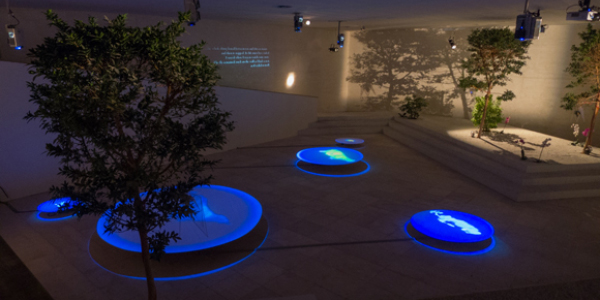I just returned from our annual Europe trip, and this year I attended the 55th La Biennale di Venezia, which is an International Art Exhibition that takes place every two years in beautiful Venice, Italy. This year’s Biennale didn’t seem to have met the expectations of many visitors compared to the previous years, but still there was enough great art to get inspired from and recharge my creative energy. It was impossible to see everything within 3 days, and I missed a few good exhibitions which I wanted to see. But in this post (Part I) are some of the highlights I was able to catch (click Part II for more photos of the Biennale):
Nordic Pavilion: Artist Terike Haapoja
Designed by the Pritzker Prize laureate Sverre Fehn, this pavilion is the most fascinating and elegant architecture seen in the Giardini. Utilizing the architecture and the trees that grow inside the space, the artist Haapoja reassesses our relationship with nature through technology in this exhibition titled Falling Trees. She has converted the pavilion into a research laboratory of sorts, a space for an open dialogue between art, natural science and environmental ethics.
Republic of Korea: Artist Kimsooja
In To Breathe: Bottari, Kimsooja transformed the pavilion into an infinite space where we see our existence on multiple levels. Using mirrors and translucent films that diffracts the natural sunlight into rainbow spectrum of light in the interior space, the experience is transcendental. The space is also filled with the sound of the artist inhaling and exhaling, bringing it to life.
Russian Pavilion: Artist Vadim Zakharov
Zakharov’s installation is inspired by the Greek mythology, Danaë: she was impregnated by the god Zeus, who appeared to her as a shower of golden rain. In the pavilion, golden coins are rained down from the top, symbolizing fertility and abundance. Only the female visitors are allowed into the lower floor, with an umbrella as a protection, and collect the golden coins to refill the bucket in the next room (we were allowed to keep one coin). The bucket, when filled, is hoisted up to the top floor to be put back into the pile of coins that fall again and again. On the floor above, a man sits and watches the coin shower. His presence is accompanied by walls filled with phrases: “Gentlemen, time has come to confess our Rudeness, Lust, Narcissism, Demagoguery, Falsehood, Banality, and Greed, Cynicism, Robbery, Speculation, Wastefulness, Gluttony, Seduction, Envy and Stupidity.” The installation addresses the role of men and women and the greediness of the society.
Chinese Pavilion: Artist Shu Yong
I liked this installation by Yong, Great Wall of Guge Bricks. It is a reflection on the divide between eastern and western values, and the googlization of culture in modern society. “Guge” is the Chinese pronunciation for Google, and the words and phrases were translated from Chinese to English, word for word, using google. The translations are at times quirky and off, such as “voluptuous ashamed”, “boyfriend menu” or “age tax” (as you may know if you’ve ever tried Google Translate). The transparent bricks symbolize the transparency which the internet brings to our modern society; the wall, however, is a metaphor for the divide that still exist between different countries, nations and individuals even in the age of globalization.
Belgium Pavilion: Artist Berlinde De Bruyckere
This is a strong installation by De Bruyckere. Cripplewood is a massive tree trunk with jumbled branches, all cast in wax with flesh-like color. She has wrapped pieces of fabric around the knobs and ends of many of the branches, like bandages on broken limbs. It assumes a form of mutilation, vulnerability and uprootedness. The artist takes inspiration from literature and film history.
USA Pavilion: Artist Sarah Sze
The installation of Sze, Triple Point, was quite refreshing in a way that her work displays an obsession that drives her creative process. Using objects and materials found locally, she creates a microworld of some sorts that resembles a mad scientist’s laboratory and fantastical world. For the 55th Biennale, the pavilion was commissioned by the Bronx Museum of the Arts.
Romanian Pavilion: Artists Maria Alexandra Pirici, Manuel Pelmus
An immaterial retrospective of the Venice Biennale is the theme Romania expresses through performance pieces. The artists take the entire history of the Venice Art Biennale through the art of choreography and dance. The performers animate a selection of images and representative works they feel are symptomatic of modern art within the last century.
Brazilian Pavilion: Artists Hélio Fervenza, Odires Mlászho, Lygia Clark, Max Bill, Bruno Munari
I loved the Brazilian Pavilion for its display of pure structure and form. Inside/Outside showcases brilliantly constructed, complex yet beautiful artwork pieces commissioned specifically for the exhibition. Both Fervenza and Mlászho have frequently experimented with the Möbius strip – the structure studied by August Ferdinand Möbius in 1858, and formed by gluing together the opposing ends of a twisted band. And it is evident in their works the application of the formal intelligence of the Möbius strip.
Click here for Part II >>































